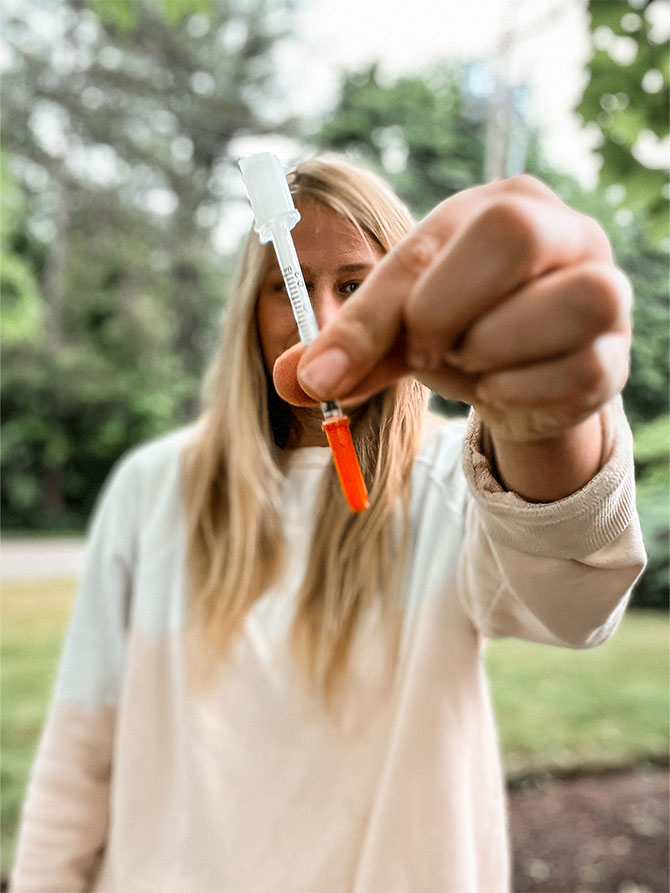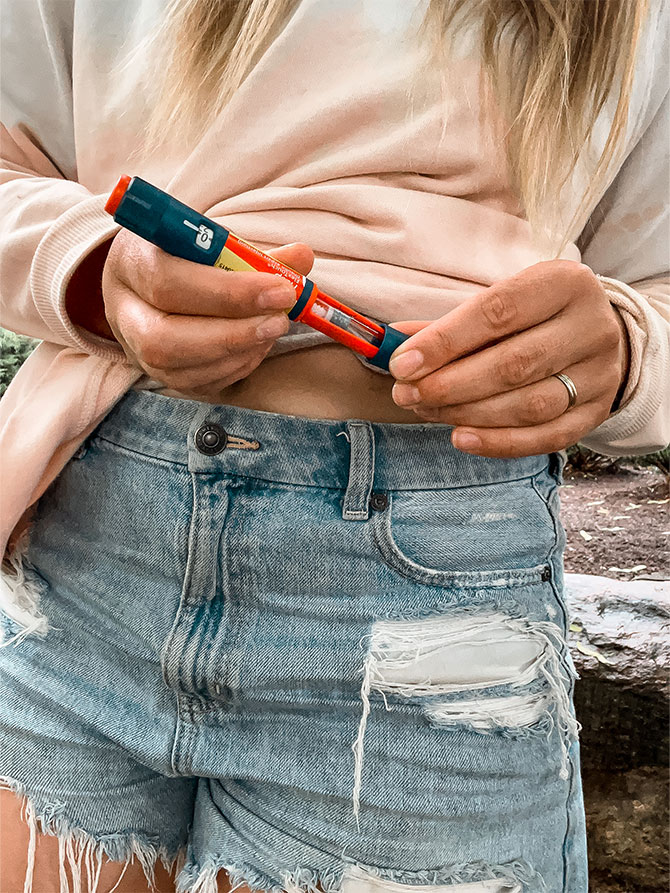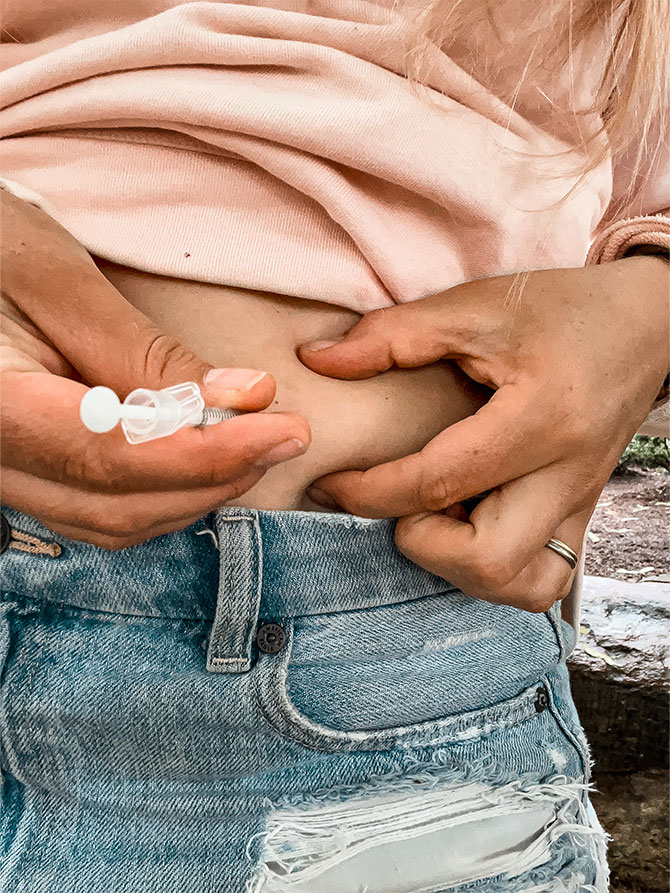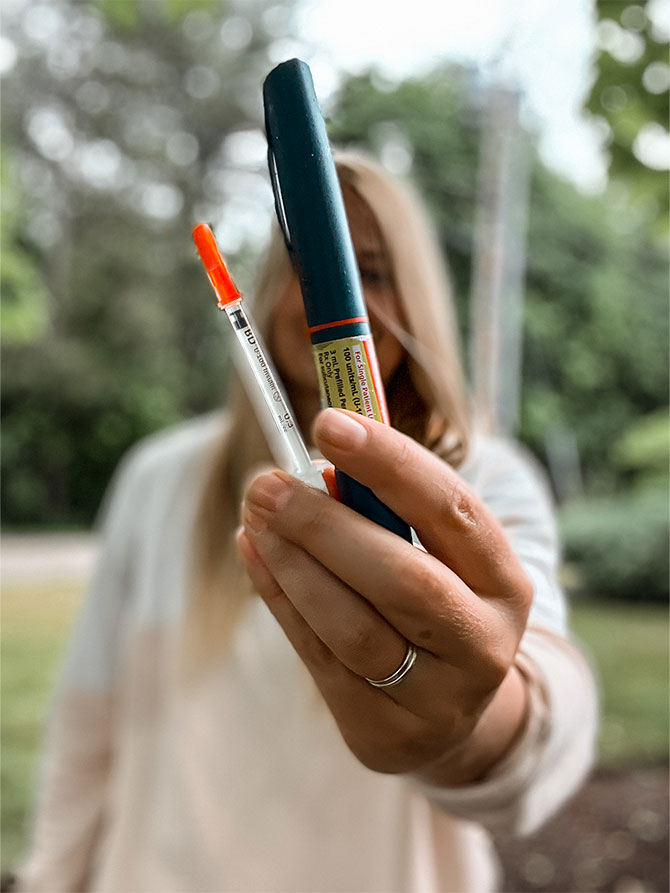If you’ve ever thought about taking an insulin pump break or have never taken one and have wondered why the heck would someone even want to? Then keep reading because this post is all about navigating (and mastering) a pump break …and how I failed.
If you want to jump around here are the different sections:
Why You Might Need an Insulin Pump Break
How to Take an Insulin Pump Break
Pros and Cons of an Insulin Pump Break
Why You Might Need an Insulin Pump Break
There are a few reasons why someone might want to take an isnsulin pump break:
- Cost Savings
- Desire for Basic Diabetes Management
- Don’t Like Devices on Your Body
- Don’t Like the Attention the Devices Bring
Cost Savings
Depending on your insurance, diabetes devices can be completely free OR you could have to pay full price for them until you hit your deductible (and even then you likely still have to pay 20% until you hit your max out of pocket).
If you’re in the camp of having to pay full price for your insulin pump and/or CGM then it can (and will) get expensive FAST!
For me, I was in this camp and wanted to save a few thousand bucks. How hard could going back to injections be? Right?
Desire for Basic Diabetes Management
There’s also something to be said for diabetic simplicity.
When I was first considering a pump break I had it in my mind that MDI would be simpler than pumping.
I wouldn’t have to order the pumps or the adhesive stickers, I wouldn’t have to worry about changing a site every 3 days, dealing with carrying around a PDM all the time, or getting my pump caught on clothes or purse handles.
MDI seemed like it would bring down all the “noise” of pumps (literal and metaphorical).
You Don’t Like Devices on Your Body
While pumps and CGMS are getting smaller every year, it’s still something that is stuck on your body. It can get caught up on clothes, door handles, and purse handles. It can get closed in doors. Pulled on by baby/toddler hands.
It can be frustrating.
They can make a nice body contour dress look lumpy.
They can get in the way when you’re getting a massage.
It can be a pain when putting on lotions or self tanners.
Having something stuck to your body 24/7, no matter how helpful, can and does get annoying.
There’s a reason why “naked showers” in the T1D world are a thing. When you can be totally naked of T1D devices, there’s a moment of euphoria.
You Don’t Like the Attention Diabetes Devices Bring
If you’re wearing a device on your skin be prepared to have people ask about it, touch it, or look at it.
People are curious. And there is no changing that.
I go through phases where I don’t mind my devices being seen and other times when I try to hide them.
When I was first diagnosed I had a lot of pride in my diabetes. I wanted people to see my diabetes devices so I could talk to them about it.
Now I’m in a phase where I don’t like my diabetes being seen before me.
I want people to get to know me as Rachel. Not Rachel with T1D.

How to Take an Insulin Pump Break
When I was planning for my pump break, my endo and I talked through 5 steps:
- Figure out what long-acting insulin you want to use
- Think about how your night time dose will be broken up
- You’ll need some new supplies
- Carry more Low snacks
- Timing of MDI switch
Figure out what long-acting insulin you want to use
There are so many different forms of long-acting insulin on the market right now. Each one has a different peak time and duration. Some of the more popular ones are:
- Levemir (peak)
- Lantus (peak)
- Tresiba (steady)
Think About How Your Night Time Dose Will Be Broken Up
Look at your current pump settings. Do you take a steady dose of basal all day long? Or do you need more at a certain time.
If you take a steady dose of basal, Tresiba might be the one for you.
If you need more at certain times, try to match the peak of your long-acting insulin with your body’s need for more insulin. It’s common to break up night time doses into 2-3 injections.
New Supplies
Going from MDI a pump will require some new supplies:
- Insulin Vials & Syringes
- Insulin Pens & Pen Needles
- Alcohol Swabs
- New Case/Supply Bag
Sugar Medical is my favorite case & accessory company! Use the code T1DLiving to save 10% on your order!
Carry More Low Snacks
While you’re getting your MDI groove back it might be helpful to carry more low snacks than usual. Using long-acting insulin as your basal will produce very different results than using fast-acting insulin as your basal.
My favorite on-the-go low snacks are:
- Maple Syrup Packets
- Honey Packets
- Date Bars (like Lara Bars)
Timing of MDI Switch
OK! So it’s time to switch to MDI.
When do you do it? Morning or night? How much do you cut your basal back by?
Here’s what I did…
My endo and I decided that my two doses of Levemir would be at 7am and 10PM. So when I woke up at 7AM, with my insulin pump still on, I dosed my 10 units of Levemir. I ate breakfast, and did a MDI bolus for my food. At lunch time I cut my insulin pump basal back by 50% and by dinner time I deactivated the pod.
That’s it.
When my insulin pump break was over (I gave it a good 3 week run) I just slapped on a new insulin pod, decreased the basal by 90% for the first 5 hours or so (because i still had Levemir in my system), then 50% for about 5 hours, then ran my regular basal rates.

The Pros and the Cons of an Insulin Pump Break
Pros and cons are subjective. What is a pro to me, might be a con to you and vice versa.
My list of pros and cons CHANGED once I got into my pump break. I had a few misconceptions about how i thought things would pan out.
Pros of MDI (BEFORE the switch)
- More discrete
- Less money
- Less “noise”
Cons of MDI (BEFORE the switch)
- Have to get confident with injections again
- Less injection sites
- Basal isn’t as flexible (will have to pack a lot more low snacks)
THEN THE SWITCH HAPPENED….
Here’s how my list changed:
Pros of MDI (DURING the switch)
More discreteIt was actually MORE obvious/in-your-face- Less money
Less “noise”more monitoring because basal wasn’t as easily manipulated
Cons of MDI (DURING the switch)
- Have to get confident with injections again
- Less injection sites
- Basal isn’t as flexible (will have to pack a lot more low snacks)
What I Learned During My Pump Break
Looking at the Pro/Con list above, you can see that my pump break did not go as expected. ⅔ of what I thought would be pro’s turned out to be con’s. Leaving me with 1 pro and 5 cons.
So let’s talk about those two pros that quickly turned into cons:
MDI isn’t always more discrete: While I didn’t have a big white patch attached to my arm 24/7 for all to see, I did have to constantly give injections. Injections at the lunch table, injections while out to dinner, injections at the park, injections in the car. Not only were all my mealtime, snack time, and corrections doses given via MDI, but all those little “nudges” (or temp basal increases) that i would give throught the day via my pump were now being given via injections. This lead to more out of range numbers for me becuase I found myself waiting until i had a quiet moment, or waiting until I was alone to inject. I also felt more pressure to do it fast.
MDI doesn’t have less “noise”: While i wasn’t getting pump alerts, didn’t have to deal with changing a site every 3 days, and didn’t have to worry about what state the pump adhesive was in, I was dealing with more CGM alerts because I was ping ponging in and out of range all. I was also having to remember to take my basal twice a day and set alarms on my phone so i would remember. Then double and triple checking my long-acting and short acting before ANY and EVERY injection. And logging my MDI dosing into my inPen app so I could be aware of any insulin stacking.

What I Would Do Differently Next Time
If I were to take a pump break again, there are a few things I would do differently.
Look Into Other Long-Acting Insulins
During this pump break I only tried one type of long-acting insulin: Levemir. If I were to take an insulin pump break again I would definitely consider trying other long acting insulins and maybe even breaking it up even more than just twice a day.
My insulin needs during the day are drastically higher than my needs at night. Playing around with different insulins and their timings I think would have put me in a better position to avoid lows overnight and get the proper daytime coverage.
Look Into Other Fast-Acting Insulins
Because I was a bit shy/modest about where I was and who was around during the times I needed an injection, I would often put it off until I was alone or had more privacy. This meant my injections were often done late… leading to out of range numbers.
With insulins like Humalog and Novolog, though “fast-acting” still take a decent amount of time to get into your system.
Had I tried out faster-acting insulins, like Fiasp, I may have been able to stay in range even with the late bolusing because the action time is LOADS faster than Novolog and Humalog.
Plan Ahead Better
Knowing myself and how I handle MDI, I would try to plan ahead better.
Park play dates = bringing lower carb snacks so i don’t have to inject
BBQ’s and eating out = bolus a small amount before I get there and use bathroom breaks to inject again (almost to imitate a temp basal increase)
Have my long acting and fast acting be in different modals. For example, long-acting would be a vial and syringe. Fast acting would be a pen. That way there is more of a difference between the two to help prevent mixing them up.
join the conversation
What’s your experience with a pump break? Any tips or advice?
let me know in the comments below




I went 36 years with no pump. I am more than content to not go back. However, let me say, if folks want to take a break, I am all for it. Me however, I am content. Gosh I love and hate these devices we wear. I love and hate it in equal measure.
I hear that! They can be a saving grace, and at the same time such a nuisance.
I switched from pump to MDI two years ago and don’t have any intention going back. May change in the future but not now. I use an InPen by Medtronic’s with humalog cartridges. The InPen APP gives all the information a pump does. I dose basal (Tresiba) twice a day. I don’t find giving a shot at lunch or anywhere else a problem. I am discreet but all my friends know I inject and don’t even notice. I really don’t snack much so am not injecting so many times per day. Three maybe four. It is some much easier to carry supplies when traveling. And don’t have to find a spot for a lumpy pump. I am on Medicare and it is actually more expensive for me. Pump and insulin covered under part B. InPen is covered under part D and co pay is $238. Pen lasts a year. Insulin is $70 a month for both. Pen needles are a deal on diathrive. May have go back to pump when I quit working.
I love the InPen! I still use the app (even tho i’m on a pump) for when I do injections of Fiasp. The only thing that drove me crazy was having to delete my “priming doses”. But I don’t think there’s a way around that. And that’s wild about Medicare costs and how they classify the scripts/hardware… you’d think it would be the other way around. Glad you’re loving MDI and that it’s working so well for you!
Thank you for the post and sharing your experience/tips!
This article has given me a lot to consider! I am considering a pump break for two reasons: scar tissue on my stomach (where my pods usually go), and EMF’s. To clarify, I know my CGM sensor is likely a bigger issue where EMF’s are concerned, due to the fact it is blue-toothing every five minutes, all day. With that in mind, I’m only comfortable wearing it on my thigh, away from my internal organs. I’m really not comfy with the back of my arm cause it’s in such close proximity to the breasts.
With line-of-site being an issue, that’s how I ended up wearing the pods on my stomach all the time (which freaks me out from an EMF standpoint, especially since I run auto-mode at night), and now scar tissue is getting to be a problem. It doesn’t seem to be affecting absorption (yet), but I get these swollen “knots” where the pod was, that hurt even days or weeks later even though they aren’t infected. There’s not enough surface area to avoid those knots all the time, not to mention I don’t like wearing the pod low enough that the waist of my pants interferes.
I could avoid needing to worry about line of site if I didn’t use auto-mode at night. But the stomach is the only place on my body I have consistently gotten good absorption. My lower back never worked well, my arm never worked well (not to mention it was always super painful there), and I’m just not willing to wear it on my hip or thigh…I have tried both spots but I’m just vain enough that I’m not cool with it. (Like most women, my pants are fitted enough that it’s so painfully obvious there’s a giant bump there).
I don’t think it will save me money to switch…I’ll save a little on pen needles/syringes over pods, but will end up spending more on insulin in the end cause I pay a % and the long acting I can use on my plan is pricey.
Do you know if there is any other app that has a bolus calculator, like the InPen app, if one wanted to only use syringes? There used to be a handful of them, and I think they’ve all been abandoned. MySugr seems good but the bolus calculator (the feature I really want) is not available in the US. I’d love to hear if anyone knows about another app that has similar functionality!